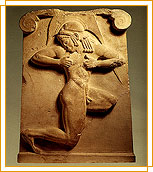The events and rules of running
The stade was the basic racing contest and the oldest
competition. At Olympia it was the only contest from the 1st (776 BC) to the 13th Olympiad
(728 BC). As a matter of fact due to its importance, it was
customary for the victor in this event to give his name to
the Olympiad. the 1st (776 BC) to the 13th Olympiad
(728 BC). As a matter of fact due to its importance, it was
customary for the victor in this event to give his name to
the Olympiad.
The diaulos was also a racing contest, during which four runners should cover the distance of two stades (approximately 400 meters). It was introduced in the Olympic program in the 14th Olympiad (724 BC) and, like the stade, there were preliminaries and final competitions.
The dolichos was a long distance race, where the athletes had to cover a distance of 7-24 stades (1,400-4,800 meters). This event was introduced in the 15th Olympiad (720 BC) and Acanthus from Lakonia is mentioned as the first victor ever. The dolichos is believed to have originated from the distances covered by the messengers of the "sacred truce" and the imerodromoi or dromokirikes, that is the messengers that delivered news and messages throughout Greece.
The hoplite race was a short distance race and one of the most spectacular contests. The runners covered the distance of two stades -on rarer occasions of four- wearing a helmet, shin plates and carrying a shield. Pausanias (V.12.8) mentions that there were 25 shields at the temple of Zeus at Olympia, which were given to the competitors so that all the athletes should carry shields of similar weight. This contest was introduced in the program of the 65th Olympiad (520 BC) and according to tradition it took place in honor of a hero that died in battle.
There was also a semi-distance race, the hippios, which was included in the Nemea, Isthmia and Panathenaea Games as well as in other local competitions, but it was not part of the Olympic events. The runners had to run four times the distance of a stade (approximately 800 meters), which was probably the same with the one of the Hippodrome, something that probably gave the competition its name.
All the athletes started the race simultaneously after a specific signal, while those that started earlier were whipped or expelled from the competition. There was a code of honor followed by all the competitors. According to the rules of the code, it was not allowed to hinder the opponents by pushing, hitting or holding them and above all the athletes should refrain from bribery and using magic spells.
|
